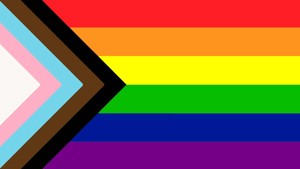Pride Flag
What are the black and brown stripes for?

Well, first we have to establish that there are a lot of “pride flags,” and there’s no “official” flag. There’s no governing body that certifies these things.
The original pride flag was designed for a parade in San Francisco in 1978. It had eight stripes. Since then, dozens of variations have been introduced, both for the LGBT community as a whole, and for sub-sections within it.
The most popular variation today is the “Progress Pride Flag” by Daniel Quasar (pictured), first introduced in 2018. This is the one that has the triangle shape on the left and which incorporates the black and brown stripes.
Those stripes represent “marginalized people of color,” specifically transgender people of color (note the positional correlation between the black and brown stripes, and the blue and pink stripes which represent transgenderism).
It was based off a flag introduced at the 2017 Pride Parade in Philadelphia which first included the two new colors.
An article about the flag quoted an anonymous source:
The black and brown stripes are an inclusionary way to highlight black and brown LGBTQIA members within our community…
This version of the flag gathered some momentum when Qausar launched a successful Kickstarter campaign for its production.
Why I Looked It Up
I was sitting in a restaurant in Lincoln, Nebraska that had the flag hanging on the wall. I got to wondering about it.
Postscript
Added on
I found an entire website devoted to explaining the different pride flags: Pride Flag Identification Guide . There are a lot of them.